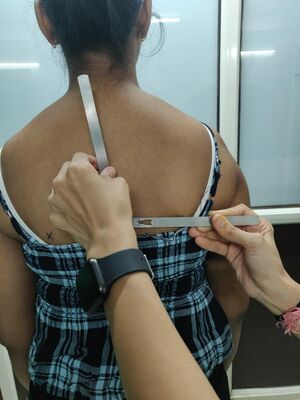Scapular balance angle: Difference between revisions
Ruchi Desai (talk | contribs) No edit summary |
Ruchi Desai (talk | contribs) No edit summary |
||
| Line 3: | Line 3: | ||
'''Top Contributors''' - {{Special:Contributors/{{FULLPAGENAME}}}} | '''Top Contributors''' - {{Special:Contributors/{{FULLPAGENAME}}}} | ||
</div> | </div> | ||
== Introduction: == | == Introduction: == | ||
== | == Purpose: == | ||
The condition of altered scapular mechanics and motion is called ‘scapular dyskinesis’, where ‘dys’ indicates alteration and ‘kinesis’ indicates motion. It can be found in healthy individuals or be responsible for a syndrome characterized by several symptoms called SICK. (Scapular malposition, Inferior medial border prominence, Coracoid pain and malposition, and Dyskinesis of scapular motion). It is a collective term that refers to the movement of the scapula that is dysfunction<ref>Kibler WB, Sciascia AD. Scapular dyskinesis and glenohumeral instability. In Disorders of the Scapula and their Role in Shoulder Injury. Cham: Springer 2017:79- 89</ref> | |||
== Technique: == | |||
The Scapular balance angle measurement was obtained with the patient standing on both bare feet, with arms, pelvis, and heels together. (Figure-3) Next, the inferior angle of the scapula was marked bilaterally and the line connecting these marks and another vertical line between the C7 and T9---T10 spinous processes were drawn. Lastly, the angles formed by the line joining both inferior angles of the scapula with the vertical line running through the spine were measured with the goniometer. The SBA was defined as ‘‘the difference between the angles formed by the line joining the 2 inferior angles of the scapula with the vertical line passing through the spine. SBA greater than 7 ◦ would entail the diagnosis of scapular dyskinesia. | |||
[[File:SBA.jpg|center|thumb]] | |||
Resources | |||
*bulleted list | *bulleted list | ||
*x | *x | ||
Revision as of 09:10, 21 April 2023
Original Editor - Ruchi Desai
Top Contributors - Ruchi Desai and Kim Jackson
Introduction:[edit | edit source]
Purpose:[edit | edit source]
The condition of altered scapular mechanics and motion is called ‘scapular dyskinesis’, where ‘dys’ indicates alteration and ‘kinesis’ indicates motion. It can be found in healthy individuals or be responsible for a syndrome characterized by several symptoms called SICK. (Scapular malposition, Inferior medial border prominence, Coracoid pain and malposition, and Dyskinesis of scapular motion). It is a collective term that refers to the movement of the scapula that is dysfunction[1]
Technique:[edit | edit source]
The Scapular balance angle measurement was obtained with the patient standing on both bare feet, with arms, pelvis, and heels together. (Figure-3) Next, the inferior angle of the scapula was marked bilaterally and the line connecting these marks and another vertical line between the C7 and T9---T10 spinous processes were drawn. Lastly, the angles formed by the line joining both inferior angles of the scapula with the vertical line running through the spine were measured with the goniometer. The SBA was defined as ‘‘the difference between the angles formed by the line joining the 2 inferior angles of the scapula with the vertical line passing through the spine. SBA greater than 7 ◦ would entail the diagnosis of scapular dyskinesia.
Resources
- bulleted list
- x
or
- numbered list
- x
References[edit | edit source]
- ↑ Kibler WB, Sciascia AD. Scapular dyskinesis and glenohumeral instability. In Disorders of the Scapula and their Role in Shoulder Injury. Cham: Springer 2017:79- 89







